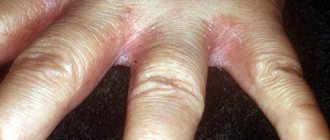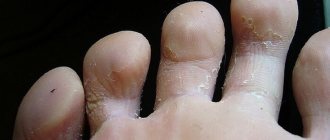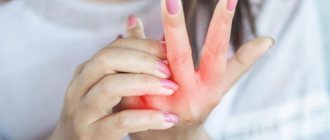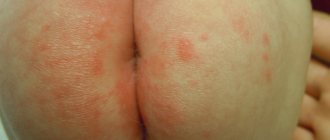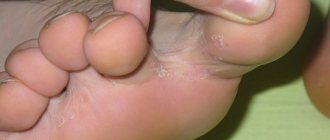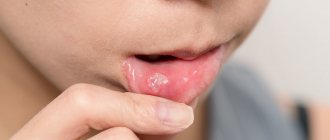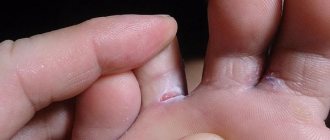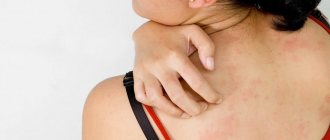The skin between the fingers is the most delicate part of the human body; irritation and redness can occur for many reasons (they are the same in adults and children). Some of them go away on their own (for example, nervous strain), others require serious treatment. There are two ways to get rid of these symptoms: the use of drugs and the use of traditional medicine.
- Medications
Causes
Redness and itching can be caused by many factors. Among them are:
- infection (bacterial or fungal),
- eczema, psoriasis, dermatitis,
- allergies to food, household chemicals, dyes,
- the presence of parasites in internal organs,
- avitaminosis,
- hormonal imbalance,
- scarlet fever (when the disease occurs in children, redness of the fingers occurs, a rash and itching in the child are noted),
- dysfunction of the kidneys and gall bladder.
As you can see, quite a few reasons can contribute to the appearance of irritation between the fingers. Poor quality care may also be the cause. Women should use cosmetics intended for their age group.
It is necessary to take this issue seriously and carry out a set of measures to cleanse, nourish and moisturize the integument. This is the only way to compensate for the lack of nutrients and vitamins.
Another provoking factor is changing weather conditions. If you intend to go on vacation and are heading from frosty Arkhangelsk straight to hot Turkey, be prepared for the appearance of unpleasant symptoms.
No matter how trivial it may sound, even prolonged exposure to direct sunlight can disrupt the natural balance of the skin due to increased moisture between the fingers. If this happens, it is necessary to temporarily limit direct contact with water.
A more rare cause of redness is an insufficient amount of vitamins A or E in the body, as well as other important nutrients.
Causes and symptoms of dermatitis on the hands
The cause of contact dermatitis on the hands is mechanical, physical, chemical or biological effects on the skin: wearing metal jewelry, latex or wool gloves, exposure to household products, plant sap, pollen, ultraviolet radiation, cold, cosmetics such as nail polish or skin cream. hands
Allergic dermatitis on the hands develops under the influence of allergenic substances that enter the body - medications, food products, dust, chemical fumes. In this case, acute inflammation of the skin is called toxicerma. Allergic hand dermatitis often develops in people who have a predisposition to other allergic diseases, for example, bronchial asthma, seasonal allergies, etc. The appearance of skin lesions on the hands can take from a few minutes to several months after the allergen enters the bloodstream.
Genetically determined hypersensitivity of the immune system to a certain factor is the cause of atopic dermatitis.
Dermatitis on the hands is accompanied by vivid symptoms. The first of these is itching, which leads to scratching of the skin. Redness, burning, small watery blisters or blisters appear on it. The joints on the hands - fingers and wrists - become difficult to bend due to their swelling, the skin loses its elasticity, and deep, weeping cracks appear. It becomes difficult to move your hands, even washing them or putting on gloves causes pain. In addition, due to discomfort and itching, sleep is disturbed; the patient may wake up several times during the night.
Fungus
One of the most unpleasant and common contagious skin diseases is called mycosis. It is provoked by a fungal pathogen. The disease develops quickly under favorable conditions: weakened immunity, past infections, addictions.
Infection occurs quite easily - it is enough to touch the things of a sick person or come into contact with him. The largest tissue damage occurs in the nail area. The symptoms begin this way: most often, after a shower, redness appears between the fingers, which, in addition, also itches. The edge of the nail plate changes its shape, which is accompanied by painful sensations. Then it becomes deformed, brittle and weak.
Important! If the development of the fungus is not stopped at this stage, then red spots appear all over the body.
Read also: Antifungal drug Itrazol: instructions for use for thrush and mycoses
Recipes for homemade hand masks
Depending on the expected result and the specific problem, use one of the proposed recipes to combat dry hand skin:
- Take the following ingredients - half a banana, honey and butter - a tablespoon each. Mix everything until smooth in a water bath. Distribute evenly on your hands, hold for half an hour;
- cucumber plus oatmeal - grate the vegetable, chop the flakes. Mix the mixture and apply to the skin. Keep for 15 minutes;
- an effective cream mask - 100 ml of boiling water, a couple of tablespoons of St. John's wort, one tablespoon each of lanolin and olive oil. Brew the herb in boiling water, and the oil in a water bath. Strain the mixture, mix with oil and lanolin. Leave for two hours.
Allergic dermatitis
This disease is not contagious, its nature comes from the specifics of the immune system: when any harmful element appears, it tries to overcome it through a powerful release of histamine into the blood. As a result, the blood vessels dilate and a rash, inflammation, and itching appear on the skin. Therefore, even in this case, if redness appears between the fingers, it is necessary for an allergist to prescribe treatment.
There is a second scenario for the development of events. The first sign may be ordinary dry skin, which remains unattended and begins to develop.
Allergies can occur due to the action of various pathogens: plant pollen, chemicals, medications, animal hair, food additives, perfumes, building materials, insect bites. This subtype of allergic skin reaction, like urticaria, involves red spots with a circumference of about 10 cm. They can pass without a trace, but itching, fever and severe weakness persist for some time.
Possible locations
Based on the location, you can roughly determine the cause of redness.
Redness between fingers
Red spots between the fingers in children may appear for the following reasons:
- Scabies infection. Scabies in children appears in spots between the fingers, on the wrists and hands, on the stomach, feet and elbows. The spots are often covered with blisters and cause severe itching. Infection occurs through direct physiological contact of a healthy person with a sick person.
- Fungal diseases appearing on the palms and between the fingers. The symptoms that appear cause burning and itching. Cracks may form on the baby's delicate skin between the fingers and on the arms. If the disease is not eliminated in time, then re-infection of the child’s body may occur through the cracks that appear.
- Dermatitis (contact ) forms on the hands and between the fingers. The causes of the disease may be contact with household chemicals or chapped hands.
The reasons for the appearance of spots between the fingers can be various factors. The spots can be of various shapes, sizes, and shades.
Redness of the hands and feet
A rash forms on the arms and legs for the following reasons:
- Chickenpox disease. This is a fairly common illness in children. With chickenpox, simple, small red spots develop into blisters. They begin to appear on the head, face, body, arms and legs. With this disease, the child’s body temperature rises, pain in the head and weakness occur.
- The spots may be caused by insect bites . During the summer, arms and legs are often not protected by clothing and are more susceptible to bites.
- If the baby has vascular diseases , then the rash on the child’s legs appears in the form of small dots or looks like bruises. This disease is quite dangerous and cannot be cured at home.
- A red (ring-shaped) rash on the limbs and body can occur with rheumatic fever. This disease is very dangerous and in some cases causes complications. Children who have recently had a sore throat are especially at risk.
- With meningococcemia, the resulting rash does not itch. The spots have an irregular shape. There is a significant increase in body temperature, the child becomes lethargic and drowsy. If a child exhibits such symptoms, it is necessary to urgently call an ambulance and take the child to the hospital.
Eczema
Very often, eczema begins with peeling and dry skin between the fingers.
This is a dermatological disease that manifests itself with the following symptoms:
- thickening and peeling of the epithelium,
- the appearance of a rash in the form of blisters,
- the appearance of itching,
- deterioration of skin color.
The nature of the disease is different - it occurs both as a result of ill health of the internal organs and as a reaction to chemicals.
Most often, people working in the fields of pharmaceuticals, construction, cosmetology, cleaning, agriculture, and food processing factories are susceptible to eczema.
The specificity of the treatment of this disease is such that, due to severe itching, patients scratch the affected areas of the skin until they bleed, which also causes a bacterial infection. In addition, small bubbles with liquid, skin thickening, and swelling appear. Eczema and allergies should not be confused, since these diseases have different natures and, accordingly, different treatments.
It is important to know! Eczema is a very dangerous disease, from which it is impossible to cure, since it goes into remission.
The dangers of not treating irritated hand skin
The danger of skin diseases is often underestimated, perceiving dermatological pathologies solely as a cosmetic problem that poses a threat only to appearance. Often, such careless attitude towards skin health can lead to serious consequences. Fungal diseases are especially dangerous, poisoning the body and harming other organs.
Cracked skin becomes an entry point for infections that affect the entire body. Skin diseases can initiate oncogenic processes.
Timely treatment is the way to avoid serious consequences and complications. An advanced disease is a threat both to your wallet (the more advanced the disease, the more difficult, and therefore more expensive, treatment) and to your health.
Lichen
Such an unpleasant disease as lichen can spread to a person from a domestic or street animal, and even from touching the sand on which it was sitting. The disease appears in the form of pink spots with a red rim; they quickly increase in size and spread throughout the body. In this case, you cannot practice self-medication; you must consult a doctor who will prescribe medications in the form of ointments and cauterization with iodine.
Treatment
To get rid of the disease, the use of pharmaceuticals is required. To eliminate discomfort in children, medications are needed that are not contraindicated at a particular age. It is imperative to read the instructions for using medications and coordinate their use with your doctor so as not to harm the child.
Skin diseases are treated as follows:
| Disease | Treatment for adults | Treatment for children |
| Contact dermatitis | Hormonal ointments (Fucicort, Advantan, Lokoid) | Anti-allergenic agents (Fenistil - from 1 month, Zyrtek drops - from 6 months, Tavegil - from 1 year) |
| Scabies | Ointments with anti-inflammatory and disinfecting effects (Wilkinson ointment). | Local agents (benzyl benzoate - from 3 years, permethrin - from 1 year, Spregal - for infants) |
| Eczema | Antihistamines (Zyrtec, Suprastin and Tavegil) | Antihistamines (Suprastin - from 1 year, Fenkarol - from 2 years, Sandosten - from 1 year) |
| Fungus | Hormonal ointments and creams (miconazole, clotrimazole, ketoconazole) | Antiseptics (Lamisil - from 12 years, Candide - for infants, Mikozan - from 4 years) |
| Prickly heat | Antibacterial agents (tetracycline ointment, Baneocin, Levomekol) | Anti-inflammatory ointments and creams (zinc ointment - for infants, Bepanten and Desitin - from birth) |
| Hives | Compress solutions (salicylic acid, diphenhydramine, menthol) | Sorbents (Smecta and Enterosgel - for infants, Lactofiltrum - from 3 years) |
| Psoriasis | Products based on solid oil (Magnipsor, Kartalin, Solipsor) | Glucocorticoid ointments 0.5% (Prednisolone - from 1 year, Flucinar - from 2 years, Lorinden - from 10 years) |
To treat pathologies, the doctor may prescribe drugs from other groups (for example, antihistamines are also used to get rid of prickly heat). The method of use and dosage of medications are indicated in the instructions for each of them.
If the redness is not caused by diseases, then general treatment recommendations will help. With their help, you can eliminate the symptom (itching, redness), but you cannot get rid of the cause of the discomfort. For this purpose, drugs and folk remedies are also used.
Medications
To cure inflammatory processes on the skin, you need to consult a dermatologist. In most cases, the doctor prescribes antihistamines (anti-allergenic) drugs. They come in the form:
- ointments (Protopic, Winkilson ointment);
- creams (Gistan, Momederm);
- tablets (Claritin, Cetrin);
- drops (Zodak, Suprastinex).
Hormonal (Sinaflan, Elokom) and non-hormonal agents (Fenistil, La-Cri) are also used.
Vitamins
You can remove skin irritation caused by a lack of nutrients and reduced immunity by taking special complexes. The following vitamins are needed:
- A, E, C (retinol, tocopherol and ascorbic acid) - increase immunity;
- group B - participate in hematopoietic processes;
- F (essential fatty acids) - heal wounds, eliminate inflammation.
Vitamin complexes for adults containing the listed substances include:
- Alphabet;
- Vitrum Beauty;
- Complivit;
- Immunal;
- Centrum.
The following products containing vitamins are suitable for children:
- Pikovit (from year);
- Vitrum Baby (from 2 years old);
- Alphabet Kindergarten (from 3 years old);
- Complivit Oftalmo (from 3 years);
- Solgar Omega-3 (from 7 years).
Folk remedies
You can treat discomfort between your fingers with tincture of valerian and motherwort. They have an antihistamine effect. To prepare a standard lotion from motherwort tincture to treat an itchy area, you need to reduce the alcohol content to 40% by diluting it with water.
Valerian tincture should be diluted with half a glass of water and drunk half an hour before meals (the number of drops is from 15 to 30). The drug will calm the nervous system and eliminate allergy symptoms.
It is useful to keep your hands in herbal baths. For their preparation and use you need:
- Mix 1 tbsp. l. oak bark, string, chamomile, pour 600 ml of water.
- Leave for half an hour.
- Dip your hand into the liquid if there is redness between the fingers.
These decoctions will have a disinfecting, soothing and anti-inflammatory effect.
You can reduce irritation and soften the skin using homemade ointments. Ingredients and process for preparing effective products:
| Type of ointment | Ingredients | Cooking method | Application |
| Oil-wax |
|
| Use twice daily |
| Olive-oat |
|
| Apply a thick layer for 20 minutes |
| Combined |
|
| Apply to cotton cloth and secure with a bandage on the affected area. Make a compress at night and change it in the morning |
Before using folk remedies, you should consult a doctor who will prescribe a safe course of treatment. Otherwise, the condition may worsen and allergy symptoms, irritation, itching, and redness will become more pronounced.
It is prohibited to use the products if you have an individual intolerance to the components specified in the recipe.
Other reasons
Avitaminosis. Most often it appears in the spring, due to a deficiency of nutrients and vitamins in the body, and is not a serious disease. To treat dry skin and redness between the fingers, you need to eat more seasonal vegetables and fruits, citrus fruits.
Household chemicals. With constant contact with strong substances, redness and rash may appear on the hands, which may indicate the development of eczema or dermatitis.
A common cause of flaking and dry skin can be genetic predisposition, excessive use of soap, as well as other hygiene products. In addition, damage to other parts of the body is possible.
Irritation and redness of the skin can result from insect bites. A particle of poison entering the epidermis causes a local allergic reaction in the body.
What means of relieving irritation help faster and better?
To determine which treatment method is more effective, it is necessary to understand the cause of peeling. If excessive dryness is the result of a disease, then therapy begins with a visit to the doctor. Without drug treatment, it is impossible to get rid of the pathology.
If the cause of irritation is external factors or improper care, medicinal cosmetics, baths, and wraps will cope with the problem. Regenerating masks work well.
Keep in mind that to achieve a visible effect, it is advisable to approach the problem comprehensively - to combine medications, traditional medicine and cosmetic care products.
Medicines
To relieve itching and inflammation, antihistamines are prescribed, such as Claritin, Cetrin, Fenistil, Suprastin, Loratadine.
If there are bacteria in the body, they must be suppressed with the help of antibiotics. Which pills should be taken can only be decided by your doctor. As for local external treatment, Erythromycin ointment and other creams that protect inflamed skin areas from the spread of microbes are excellent.
Read also: Candiderm: pharmacological properties, instructions for use, price and analogues of the drug
Hormonal ointments (Clotrimazole, Miconazole, Ketonazole) are used to suppress fungal infections. If the test results reveal mycosis, the doctor may also prescribe boric acid, rivanol or resorcinol.
In turn, hormonal ointments are also used for dermatitis. The following drugs are suitable: Lokoid, Advantan, Fucicort. They will also help in the treatment of psoriasis. In addition to the above-mentioned remedies, tar and zinc ointment are used; these preparations are based on solid oil (Solipsor, Kartalin, Magnipsor).
Medicinal methods of control
Compared to other areas of the body, the skin on the hands is considered the most vulnerable, since it practically does not contain sebaceous glands and nutritional moisture. That is why this area of tissue is easily injured under the influence of numerous unfavorable factors. You can protect your hands only with proper care and comprehensive strengthening of the immune system , not forgetting about the treatment of chronic diseases.
If the skin between your fingers suddenly turns red and begins to peel, characteristic itching and swelling appear, then you should urgently consult a specialist. Depending on the overall clinical picture, doctors will prescribe the most effective drugs.
Modern antibiotics are used to suppress bacteria . But for external treatment, Erythromycin ointment is best suited. If a scabies mite has been detected, then the patient is prescribed external preparations with a disinfecting and anti-inflammatory effect (Wilkinson ointment). If there is a fungal infection in the body, then hormonal creams and ointments are used (Ketonazole, Clotrimazole, Miconazole). To effectively treat such diseases, doctors often prescribe boric acid, Resorcinol, and Rivanol to their patients. If a patient has been diagnosed with mycosis, then he is strictly prohibited from contacting other people so as not to infect them.
Originally posted 2018-07-04 13:30:50.
Traditional methods
These treatment methods are used strictly after visiting a doctor and prescribing the necessary medications. Folk remedies are only an addition to the main treatment. The following procedures have proven themselves to be effective:
- First pour boiling water over the blueberries (100 grams), then cool, and apply the crushed berries, wrapped in gauze, to the source of inflammation.
- Olive oil has healing properties. They can be used to rub problem areas. Everyone also knows the beneficial properties of sesame oil.
- Grate the carrots on a fine grater, wrap in gauze, and apply to the reddened area of the skin.
First aid for itchy skin
Undoubtedly, any skin problems should be eliminated exclusively in a therapeutic way. If it is not possible to urgently consult a doctor, then you can use the following methods that will help eliminate the main cause of itching :
- Application of oatmeal compresses. They are filled with regular boiling water and steamed. The finished pulp is wrapped in several layers of gauze and applied to the hands. A good effect is achieved due to the fact that oats have excellent healing properties and also help eliminate skin inflammation.
- Lubricate the inflamed area of skin with butter or fat. It is prohibited to use softening creams of cosmetic origin. Fat must be exclusively natural. It will nourish the skin, eliminate dryness, flaking, relieve inflammation, which will relieve the itching sensation.
- Wrap a few pieces of ice in a towel and apply it to the affected area of skin. This procedure will help reduce discomfort and alleviate the general condition. It is important to remember that holding ice for longer than 15 minutes is prohibited, otherwise the connective tissue of the finger joints may become inflamed.
- Contact exclusively with warm water, as too hot or cold water will only aggravate the overall clinical picture.
- During the period of exacerbation of the disease, it is necessary to avoid wearing synthetic clothing, as well as using detergents with artificial dyes and flavors. To wash your hands, it is best to use tar or laundry soap.
When the main causes of the disease have been eliminated, it is necessary to urgently contact a medical center to receive qualified assistance. In 95% of cases, rapid redness of the skin, itching, swelling and rash indicate that a person has an acute allergy. If it is not eliminated in a timely manner, swelling of the larynx and even anaphylactic shock may develop. The latter condition almost always ends in death.
Prevention
Below is a list of tips to avoid the above problems:
- Proper diet: minimize the consumption of sweets, fatty, salty foods. Eliminate bad habits.
- Analyze your body’s reaction to allergic pathogens and avoid contact with them.
- Consistent change of bed linen.
- Compliance with personal hygiene rules.
- Avoid prolonged contact with direct sunlight.
- Do not avoid periodic preventive examinations.
- Continuous skin care for the entire body.
It is the hands that are most susceptible to fungal infections, so special attention should be paid to taking care of them. Of course, the fact that you follow all the above tips does not provide a 100% guarantee that this problem will not affect you. However, they will help avoid many unpleasant problems.
Mycoses
It is enough to scratch, for example, an insect bite with unwashed hands, so that the smallest fungal spores end up on the skin. Having not met the proper resistance from the immune system and finding itself in heat and moisture, the fungus begins its activity that affects the epidermis. Representatives of the genus Candida do not even need a carrier - they are always on our skin and are activated under favorable circumstances.
Dermatomycosis
The first thing a person who has been attacked by fungi pays attention to is itching between the fingers. At the same time, a crack appears, which becomes larger every day. The next symptom is peeling of the epidermis. The skin peels off in micro flaps. Without treatment, there is a further increase in the area of the lesion, and the entire palm begins to suffer.
Candidiasis
Interdigital candidiasis can be suspected by the characteristic location of the rash - between the middle and ring fingers. At the first stage, the manifestations of mycosis are insignificant; a person sees only a few bubbles, which do not cause any particular trouble and soon disappear. Then the process gets worse:
- there is redness and itching between the fingers,
- the boundaries of the lesion are outlined,
- a little later the hearth acquires a whitish tint,
- there is swelling and tissue maceration.
- the area is ulcerated,
- the erosion does not spread and always remains between the fingers.
When should you contact your healthcare provider?
Call your healthcare provider if you experience any of the following.
- temperature 100.4°F (38°C) or higher;
- chills;
- symptoms do not go away or get worse;
- any of the following symptoms appear on the skin of your palms or soles: skin that is hard, warm, or hot to the touch;
- bright yellow or green discharge;
- bleeding.
- unpleasant odor from the palms and feet;
- increasing redness or swelling;
- increasing pain or discomfort;
to come back to the beginning
